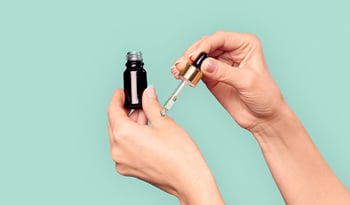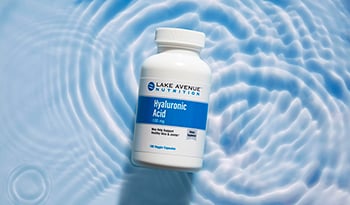Top 5 Ingredients for a Nourishing Winter Skincare Routine
OŚWIADCZENIENiniejszy blog nie ma na celu diagnozowania...
- W tym artykule:
- Seasonal Skincare Approach
- Humectants, Emollients, and Occlusives
- Top Ingredients For Winter Skincare
- The Takeaway

Winter is the season of snow, sledding, and hot chocolate by the fire. I love some winter fun, but know what I don’t like about the cold months? The way my skin reacts to the harsh winter weather.
Dryness, peeling, sensitivity, and dehydration are just a few of the issues the skin can face during winter. In some parts of the country, it’s already warming up for Spring, but for those of you who are still dealing with a cold and dry climate, this article is for you. We’ll look at how to approach your skincare during this time of year, and the top five ingredients to keep your skin glowing all the way through to summer sun!
Seasonal Skincare Approach
Many skincare users mistakenly continue with the same skincare routine year-round, or simply slap on an extra layer of their moisturizer when it’s cold out. But the dramatic weather changes that occur in many parts of North America mean our skin faces completely different conditions and challenges from season to season. Going from a humid, hot summer to a dry, chilly fall and winter means our skin will react to the changing conditions. Just as you change up your wardrobe, you should switch up your skincare routine, too. It doesn’t have to be an entirely new routine, but adding in nourishing ingredients and understanding how to treat your skin can help you maintain a soft, healthy, complexion throughout the year.
Humectants, Emollients, and Occlusives
Before we dive into the specific ingredients themselves, it’s important to understand the types of things you want to look for in our skincare products, so you put together a winter skincare routine that works well for your skin type. You may have heard the words “humectant,” “emollient,” and “occlusive” thrown around when it comes to skincare, but what exactly are these things?
Humectants, emollients, and occlusives are all categories of skincare products. Each performs a different function for our skin.
Humectants are ingredients that draw water into our skin. All skin needs to be well hydrated to remain plump, smooth, and healthy, no matter whether your skin is oily, dry, or anything in between! Emollients are moisturizers that help address dryness and strengthen a weak skin barrier while softening the skin. By helping maintain the skin’s natural barrier, emollients also help protect against water loss. This is essential to consider during cold, harsh weather. Occlusives form a protective barrier over the skin which prevents moisture from escaping. They are usually much heavier and can be very useful for a winter skincare routine when you’re trying to protect your skin. To summarize—every skincare routine should include humectants and emollients, and very dry or damaged skin may benefit from occlusives.
Top Ingredients For Winter Skincare
Now that we have a basic understanding of the different categories of skincare products that can be beneficial, let’s take a closer look at five powerhouse ingredients to ensure your skin remains healthy and nourished from your winter skincare routine.
Hyaluronic Acid
Hyaluronic acid is one of the most well-known humectants on the skincare market and including this ingredient in your winter skincare can ensure your skin remains hydrated. Hyaluronic acid can hold 1000 times its weight in water and skincare formulas that include this ingredient help bring water to the surface of your skin. The effect of this? Plump, hydrated skin that looks youthful and has improved elasticity. Water loss can be a major issue during the winter as the dry weather sucks the water from your skin. Including hyaluronic acid in your routine, along with other ingredients to help skin retain the water, can help address that. Look for toners and moisturizers that include this star ingredient.
Ceramides
Suffer from irritated, flaky, skin in the winter? Ceramides may be your new best friend. They are naturally occurring fats that are found in the outer layers of our skin and although they are already present in our skin, they diminish over time. Adding ceramides to your winter skincare routine can help fortify your skin barrier against the harsh winter conditions that can cause a variety of skin issues.
Moisture loss is a common problem in winter, leading to dryness, tightness, and rough-textured skin. By helping prevent water loss in the outer layers of skin, ceramides can lock in moisture, maintaining a healthy complexion that feels comfortable, smooth, and even appears more youthful. Irritation is also a common skin complaint during the winter months, either from dryness or external aggressors that can more easily penetrate the skin due to a weak skin barrier. Adding ceramides into your skincare can work to protect your skin and help soothe and reduce the likelihood of irritation. I personally find using ceramides helps reduce the redness and irritation I often deal with from colder weather.
Whether you find ceramides in lip balms, face creams, or body butters it’s a reliable ingredient for whole-body protection. Ceramides are not a flashy, overly exciting ingredient but they work extremely well for nourishing and enhancing our skin’s ability to retain water and to remain healthy during winter.
Manuka Honey
Manuka honey has a deep-rooted history as a topical treatment for a wide variety of skin conditions. Although more commonly known for its healing properties, Manuka honey products can be a strong addition to a winter skincare routine aimed at treating dry patches of skin.
Manuka honey is both a moisturizing ingredient and a humectant, so it can draw water into the skin and help the skin retain that water. Exactly what we need when the weather is cold! It is also incredibly soothing, so if the skin is feeling rough or irritated, Manuka honey products are a wise choice. If your skin barrier becomes compromised, which is more common during the winter, this makes your skin susceptible to bacteria, irritation, and possible breakouts. Manuka honey has both antibacterial and anti-inflammatory properties—it can help keep your skin healthy, moisturized, AND soothed.
Propolis
Propolis and honey are the same things, no? Nope! Although propolis is also associated with bees, propolis is a natural mixture of beeswax, bees’ saliva, and plant materials that is created and used by bees for building and sealing their hives. In skincare, propolis has become an extremely popular ingredient, and just like Manuka honey, is a multi-tasker that can treat the skin during winter. It is particularly popular within Korean skincare.
Like Manuka honey, propolis is most well-known for its anti-inflammatory, antibacterial and antifungal properties. Although this may not seem like a typical ingredient we’d look at for winter-specific skincare, it can help treat skin that is feeling chapped, weather-beaten, and sensitive. A weaker skin barrier from the dry, cold weather can cause a multitude of effects on our skin, and as a multi-tasking ingredient, propolis has the potential to both treat and protect from irritation and bacterial issues. With our skin barrier facing more challenges during winter, it’s a good plan to include these treatment-type ingredients, such as propolis and Manuka honey, to help our skin restore and revitalize.
Squalane
Squalane is an ingredient that can often be overlooked but should not be underestimated. It is an emollient oil and can be used by all skin types for moisturizing benefits. Although historically sourced from shark liver, thankfully the vast majority of squalane used in skincare today is plant-based. At the simplest level, it’s a fantastic moisturizer. It helps maintain the skin barrier by enhancing the protective layer and ensuring skin retains moisture. In turn, this helps smooth the skin and tackles any rough patches. squalane is also known to have soothing properties, meaning it can help with redness and irritation your skin may be dealing with.
Squalane often comes in the form of an oil, which can be incorporated into a skincare routine in several ways. Personally, I enjoy adding a couple of drops to my evening moisturizing cream for added nourishment. You can also warm a few drops in your palms and gently pat them into your skin before or after moisturizing. Either way, it works effectively for moisturizing and soothing.
The Takeaway
Our skin faces many challenges when the climate and weather conditions change. Noticeable winter changes include rough-feeling skin, irritation, tightness, dry patches, flaking, and general discomfort. But even if you don’t see or feel these changes, it’s important to protect your skin with these easy methods and nourishing ingredients.
DISCLAIMER: This blog is not intended to provide diagnosis, treatment, or medical advice. Content provided on this blog is for informational purposes only. Please consult with a physician or other healthcare professional regarding any medical or health-related diagnosis or treatment options. Information on this blog should not be considered as a substitute for advice from a healthcare professional. The claims made about specific products throughout this blog are not approved to diagnose, treat, cure, or prevent disease.

 Wg Katherine Spowart
Wg Katherine Spowart


